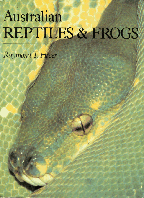Editor's note: 2009
Green Tree Pythons are now recognised as comprising two species. Theren are two further subspecies of Green Tree Python recognised. See section on Green Tree Pythons in the paper by Hoser 2009 in Australasian Journal of Herpetology "Creationism and contrived science: A review of recent python systematics papers and the resolution of issues of taxonomy and nomenclature." Issue number 2, pages 1-34.
The link for that newer paper is here:
The material that follows below on the Green Tree Python is text from the paper - A revision of the Australiasian Pythons.
(Originally published in Ophidia Review 1(1) in "Autumn" 2000 - (Publication date: October 2000)(with "Green Python" changed to "Green Tree Python"), pp. 7-27).
For the text of the full paper ![]()
 This is the Green Tree Python. There is only one species within the genus.
That is Chondropython viridis.
This is the Green Tree Python. There is only one species within the genus.
That is Chondropython viridis.
The type locality is the Aru Islands, Indonesia, south of New Guinea. Many recent workers have made synonymous this genus and Morelia, the latter name taking precedence. This author does not accept that arrangement. While it is clear that the two genera derived from the same ancestral stock, it is believed that the two have been separated long enough to warrant being placed in separate genera.
The lack of a distinct dorsal pattern of blotches and stripes that typifies all Morelia (except spilota) or a black and yellow dorsal pattern as in spilota separates Chondropython from all snakes in Morelia. There are no iridescent green Morelia. This is the usual dorsal colouration for adult Chondropython. The absence of labial pits in Chondropython is frequently cited as a characteristic that separates the genera Chondropython and Morelia. That is not so. In fact both genera have distinct labial pits. See the photos published in Hoser (1989) or O'Shea (1996) to view the labial pits in both genera.
The Green Tree Pythons are readily distinguished from all other Australian pythons. Refer to Hoser (1981a) McDowall (1975) and O'Shea (1996) for further diagnostic information. Australian Green Tree Pythons (as cited by Thomson (1935)) are more likely than the New Guinea specimens to have markings along the spine to form some sort of vertebral line or pattern. This is corroborated by other authors including the photos in Greer (1997). However the same trait is also seen commonly in south New Guinea specimens.
Specimens from the north of New Guinea are likely to have spots in a more irregular pattern.
 Specimens from around the high country of Wamena in Irian Jaya are a
very dark green with buttercup yellow spots on the back. The dark yellow
ventral scales are commonly a grey/black in colour. As with Morelia,
Chondropython is a species with considerable variation in colour,
not only between locations, but even within a single location and even
within a single litter of young.
Specimens from around the high country of Wamena in Irian Jaya are a
very dark green with buttercup yellow spots on the back. The dark yellow
ventral scales are commonly a grey/black in colour. As with Morelia,
Chondropython is a species with considerable variation in colour,
not only between locations, but even within a single location and even
within a single litter of young.
Photos of Australian Green Tree Pythons in life with exact locality data are shown in Greer (1997).
Photos of New Guinea Green Tree Pythons in life are shown by O'Shea (1996).
Refer to McDowell (1975) for further details.
The above was from the paper - A revision of the Australiasian Pythons.
(Originally published in Ophidia Review 1(1) in "Autumn" 2000 - (Publication date: October 2000), pp. 7-27).
For the text of the full paper ![]()
 Download the full paper as an MS Word document (better for printing)
Download the full paper as an MS Word document (better for printing)![]()
The Australian Green Tree Python was first formally named as a subspecies by Hoser in 2003
The Normanby Island Green Tree Python was first formally named as a subspecies by Hoser in 2009
The northern species of Green Tree Python was first formally named as a species by Meyer in 1875
The nominate race/species of Green Tree Python was first formally named by Schlegel in 1872
Webpage keywords include:Green Tree Python Chondropython viridis, Australia, Australian, Chondropython viridis shireenae, Chondropython azureus is from Northern New Guinea, species and subspecies, Chondropython adelynhoserae is from Normanby Island, PNG, Meyer, Hoser, 2009, Hoser 2003, Green Tree Python, Chondropython nominate form is from southern New Guinea and nearby Islands

 To download the original of this paper - with
photos exactly as it appeared in the journal Ophidia Review - as an Adobe Acrobat pdf file
To download the original of this paper - with
photos exactly as it appeared in the journal Ophidia Review - as an Adobe Acrobat pdf file